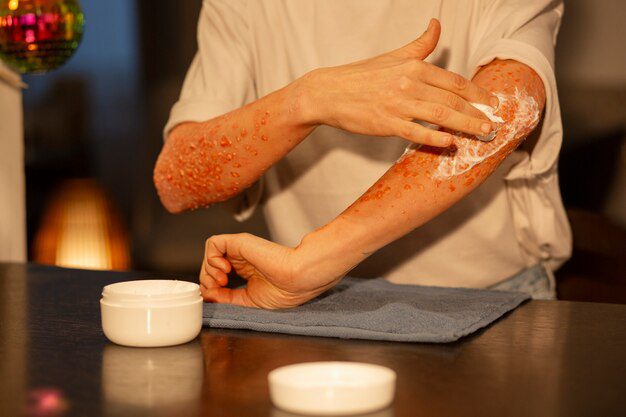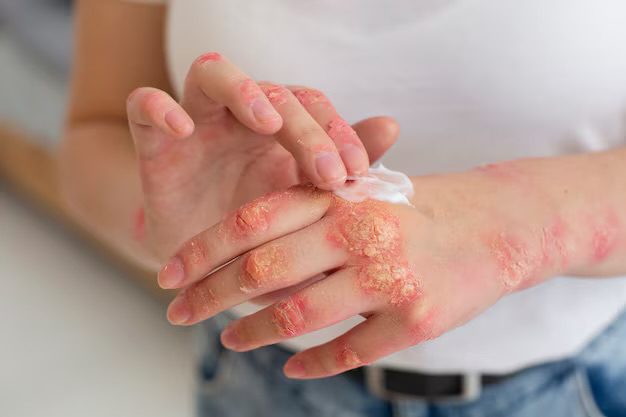This content is for informational and educational purposes only. Always consult a qualified healthcare provider.
Last Updated on July 23, 2025 by Grace Oluchi
TLDR – Key Points
What it is: Skin dependency on steroid creams causing severe withdrawal symptoms Main symptoms: Burning, extreme redness, oozing, sleep loss from itching Recovery time: 77% recover within 3 months, some take up to 2 years Treatment: No quick fix – supportive care, moisturizers, cool compresses Latest research: New studies show TSW affects mostly women under 35, primarily on face/genitals
Topical steroid withdrawal (TSW) is a challenging condition that occurs when the skin reacts adversely to the abrupt discontinuation or significant reduction of long-term topical steroid use. Often linked to prolonged overuse of corticosteroids, TSW can lead to severe physical and emotional distress, including skin dependency, social isolation, and depression.
📋 Table of Contents
Understanding Topical Steroid Withdrawal
Topical steroids, also known as corticosteroids, are commonly prescribed for managing chronic skin conditions such as eczema, psoriasis, and dermatitis. While effective at reducing inflammation, itching, and swelling, prolonged use can cause the skin to develop dependency. When use is stopped suddenly, withdrawal symptoms can manifest.
Clinical Definition: TSW is characterized by burning, itching, and erythema following sudden termination of medium- to high-potency topical corticosteroids after prolonged use (typically after at least 3 months of use). According to StatPearls medical database, the syndrome represents a form of tachyphylaxis and rebound vasodilation with skin barrier dysfunction.


What the Latest Research Shows (2024-2025)
Recent peer-reviewed studies from Clinical and Experimental Dermatology and PubMed research reveal important patterns:
- Demographics: TSW affects primarily women (81.0%) and occurs mostly on the face and genital area (99.3%)
- Symptom Profile: Burning and stinging are the most frequently reported symptoms (65.5%) with erythema being the most common visible sign (92.3%)
- Recovery Timeline: 77% of patients recover after 3 months, though some cases can persist up to 5 years
- Clinical Recognition: DermNet research shows TSW is caused by prolonged use of moderate to high strength topical corticosteroids
Immediate Symptom Recognition
A sign of topical steroid withdrawal. A person applying cream in the affected area.
If you’ve recently stopped using steroid creams and notice these symptoms, you might be experiencing TSW:
Primary Symptoms
- Intense redness and inflammation worse than your original condition
- Severe burning sensation that feels like your skin is on fire
- Uncontrollable itching leading to sleeplessness and scratching injuries
- Skin shedding and oozing that soaks through clothing within minutes
- Extreme nerve pain and loss of temperature regulation
- Emotional distress including anxiety, depression, and in severe cases, suicidal thoughts
- Social isolation due to visible symptoms and discomfort
Secondary Effects
The symptoms may persist for months or years, often cycling through phases of remission and recurrence. Patients experience significant sleep disturbances due to intense itching, substantially impacting their quality of life.
The Three Phases of TSW Recovery
Understanding these phases helps set realistic expectations:
Phase 1: Initial Withdrawal (0-2 weeks)
- Symptoms like redness and itching begin days after stopping topical steroids
- Often mistaken for the original skin condition returning
Phase 2: Peak Intensity (2-6 weeks)
- Symptoms intensify dramatically
- Increased inflammation, dryness, and discomfort
- Most challenging period requiring maximum support
Phase 3: Gradual Recovery (6-24 weeks or longer)
- Symptoms gradually improve as skin adapts to life without steroids
- Recovery timeframe ranges from 72 hours to months, with most patients (77%) recovering within 3 months
Evidence-Based Treatment Approaches (2025)
Important: There are currently no specific treatments that clearly reduce the time to resolution, according to National Eczema Association research. However, supportive care significantly improves comfort during recovery.
Medical Interventions
Primary Care Approach:
- Emollients and moisturizers as the foundation of treatment
- Cold compresses and ice application for immediate relief
- Gabapentin for burning pain management (prescription required)
- Non-steroidal topical preparations with anti-inflammatory properties
Advanced Options:
- Phototherapy: Targeted UV light therapy to improve skin regeneration
- Oral antihistamines for itch management and sleep improvement
- Systemic anti-inflammatory drugs for severe cases (medical supervision required)
Holistic Care Strategies
Anti-Inflammatory Nutrition:
- Omega-3 rich foods: Fatty fish, walnuts, flaxseeds
- Antioxidant sources: Berries, leafy greens, colorful vegetables
- Probiotic foods: Plain yogurt, kefir, fermented vegetables
- Hydration focus: 8-10 glasses of water daily to support skin barrier function
Traditional Medicine Integration:
- Traditional Chinese Medicine (TCM): Herbal remedies targeting inflammation and detoxification
- Mind-body practices: Meditation and mindfulness for stress-related flare management
Lifestyle Modifications:
- Gentle exercise: Regular walking or yoga to improve circulation and reduce stress
- Cool shower protocol: Lukewarm water to soothe irritated skin
- Breathable clothing: Loose-fitting, natural fabrics to prevent irritation
- Sleep optimization: Cool bedroom, soft bedding, antihistamines if needed
Mental Health Support
Critical Component: Many patients report dismissal by healthcare professionals, driving them to seek help from unregulated online sources, increasing mental, social and physical burden, according to PubMed research on emerging clinical problems.
Professional Support:
- Counseling services specialized in chronic illness management
- Support groups specifically for TSW patients
- Family education about the condition’s impact
Prevention Strategies
Medical Best Practices:
- Follow prescription guidelines: Use steroids only as prescribed by a dermatologist
- Time limits: Avoid prolonged use to minimize dependency risks
- Gradual tapering: Reduce steroid use incrementally under medical supervision
- Regular monitoring: Stay alert for early signs of dependency or withdrawal
- Alternative treatments: Consider non-steroidal options for chronic skin conditions
Risk Factor Awareness: TSW is linked to long-term inappropriate use of potent topical corticosteroids, particularly on sensitive areas like the face and genitals.
Real Patient Experiences
Recovery Success Story
A Reddit user shared their TSW journey:
“The initial months were unbearable, but with phototherapy and a low-inflammation diet, my skin started healing. Now, I’m steroid-free and thriving.”
Read more TSW experiences on Reddit
Holistic Healing Approach
A blogger detailed their recovery:
“Combining gentle yoga with TCM and support from an online community was pivotal in my healing process.”
These testimonials highlight the effectiveness of combining medical guidance with holistic approaches in managing TSW.
2025 Research Breakthroughs & Future Treatments
Current Clinical Research
Pediatric Studies: Recent research from PMC medical journals identified 21 pediatric TSW cases, with 60% involving facial TCS use and 69% associated with escalating steroid potency.
Social Media Analysis: A 2024 TikTok study found only 10% of TSW videos clearly defined the condition, highlighting the need for better patient education.
Emerging Treatments
- Biologic therapies: Research targeting underlying inflammation pathways
- Customized skin microbiome treatments: Products designed to restore healthy skin bacteria balance
- AI-powered monitoring tools: Wearable devices tracking skin condition for personalized interventions
Research Gaps
Published studies indicate TSW is a distinct adverse effect of prolonged topical corticosteroid use, but there remains a paucity of high-quality research evidence.
Frequently Asked Questions
What makes TSW recovery so challenging?
TSW symptoms can persist for months or years, requiring consistent care, emotional support, and medical supervision. Analysis of medical journal articles shows TSW recovery often takes more than three months, with many patients reporting years of struggle.
Are there specific diets that help with TSW?
Yes. Anti-inflammatory diets rich in omega-3s, antioxidants, and probiotics can support healing and reduce inflammation. Focus on whole foods and avoid known inflammatory triggers.
How can I stay motivated during recovery?
Join TSW-specific support groups, celebrate small improvements, and engage in stress-relieving activities like gentle yoga or meditation. Remember that recovery is typically gradual but progressive.
What are the newest treatments for TSW in 2025?
Current research focuses on biologic therapies, skin microbiome restoration, and advanced phototherapy. However, supportive care remains the primary evidence-based approach.
Should I trust online TSW communities?
While peer support is valuable, healthcare professionals caution that dismissal by medical providers often drives patients to seek help from unregulated online sources. Balance community support with professional medical guidance.
Getting Professional Help
When to Seek Immediate Care:
- Severe oozing or signs of infection
- Extreme pain interfering with daily activities
- Suicidal thoughts or severe depression
- Inability to sleep for multiple consecutive nights
Finding TSW-Informed Healthcare:
- Dermatologists with TSW experience
- Integrative medicine practitioners
- Mental health professionals familiar with chronic skin conditions
Conclusion
Topical steroid withdrawal is a complex condition requiring a multi-faceted approach for recovery. As an emerging clinical problem, TSW needs increased awareness among healthcare professionals and standardized diagnostic criteria.
By staying informed about the latest research advancements, following a structured care plan, and seeking support from qualified healthcare professionals, individuals can navigate the journey toward healthier, steroid-free skin.
The road to recovery is challenging but achievable. With proper support, evidence-based treatment, and patience, most people do recover from TSW and regain their quality of life.
References & Scientific Studies
TSW Clinical Information – National Eczema Society, 2022
URL: https://eczema.org/information-and-advice/topical-steroid-withdrawal-tsw/
Topical steroid withdrawal: an emerging clinical problem – Clinical and Experimental Dermatology, 2023
URL: https://academic.oup.com/ced/article-abstract/48/9/1007/7147043
Clinical review of 19 TSW cases – PubMed, 2023
URL: https://pubmed.ncbi.nlm.nih.gov/37119282/
Pathophysiology and Clinical Manifestations of TSW – NIH Research Festival, 2024
URL: https://researchfestival.nih.gov/2024/posters/pathophysiology-and-clinical-manifestations-topical-steroid-withdrawal
Evidence Gap Map for TSWS – Journal of Medical Internet Research, 2024
URL: https://www.jmir.org/2024/1/e57687/
Systematic review of topical corticosteroid withdrawal – PubMed, 2015
URL: https://pubmed.ncbi.nlm.nih.gov/25592622/
Topical Steroid Withdrawal (Red Skin Syndrome) – StatPearls NCBI, 2024
URL: https://www.ncbi.nlm.nih.gov/books/NBK603718/
Breaking the cycle: comprehensive exploration of TSW – PMC, 2024
URL: https://pmc.ncbi.nlm.nih.gov/articles/PMC11994697/
TikTok TSW Video Analysis – JMIR Formative Research, 2024
URL: https://formative.jmir.org/2024/1/e48389
Pediatric TSW Syndrome Review – PMC, 2024
URL: https://pmc.ncbi.nlm.nih.gov/articles/PMC11950796/
TSW Treatment Guidelines – DermNet NZ, 2023
URL: https://dermnetnz.org/topics/topical-corticosteroid-withdrawal
TSW Information Guide – National Eczema Association, 2024
URL: https://nationaleczema.org/blog/tsw-need-to-know/
Patient Community Research Call – British Journal of Dermatology, 2022
URL: https://academic.oup.com/bjd/article/188/2/288/6795529
Also Related
Skin rash: Types of skin rash, Causes, Symptoms, Treatment.
Prednisolone: Uses, side effects, warnings, and more
Prickly heat: Causes, symptoms, treatments,
Self Removal of Dilated Pore Of Winer In 2024: You Might Worsen Your Skin Condition

